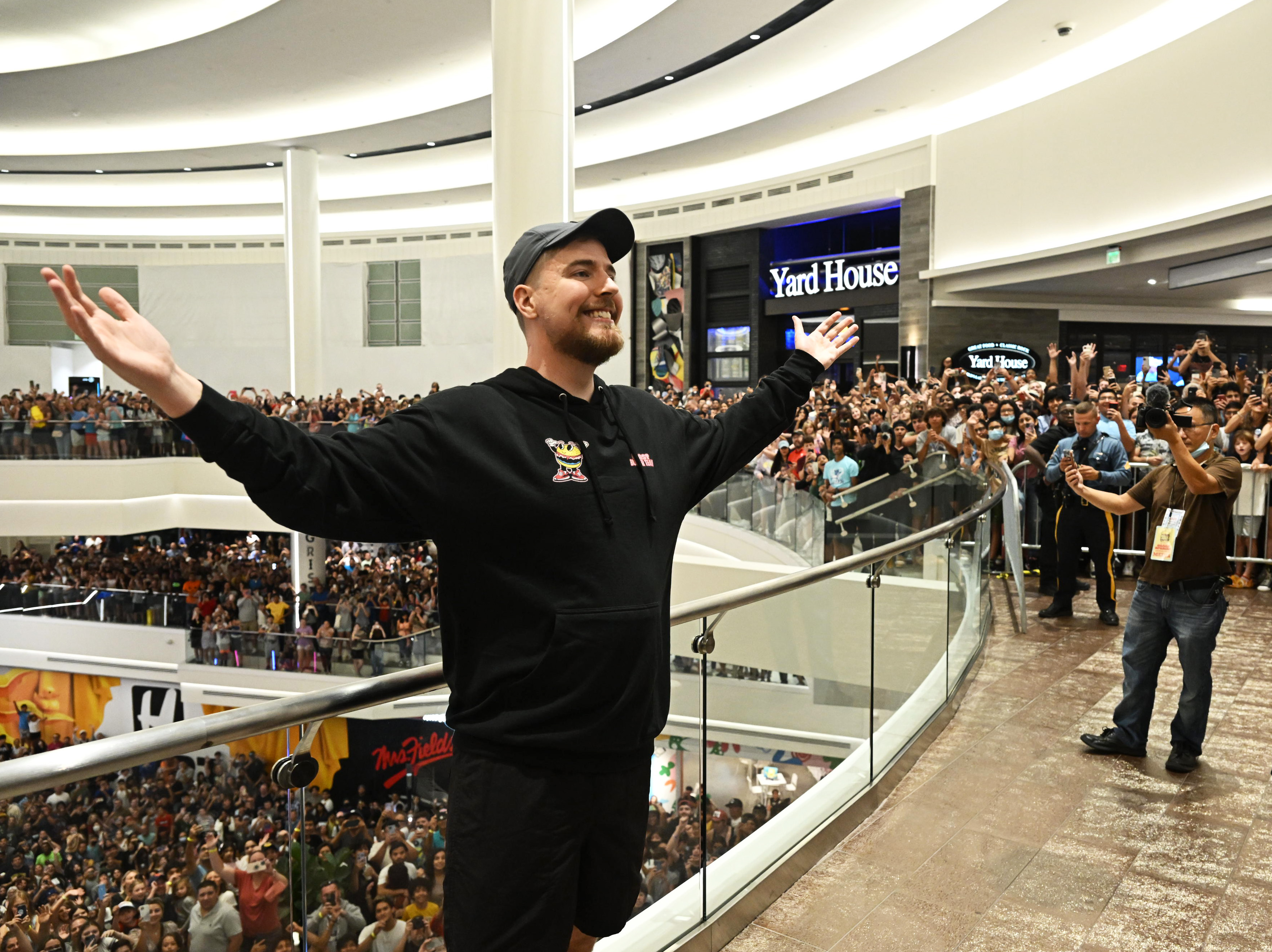Have you ever stopped to wonder about the hidden value in cutting-edge technology? Perhaps you've heard whispers about "Mr B's net worth" and felt a little curious. Well, today, we're going to talk about something a bit different, a kind of "Mr B" that represents a huge, growing area in our digital world. We're talking about the incredible potential and market value wrapped up in Mixed Reality, or MR, technology. It's not about a person's bank account, you know, but more about the collective wealth and promise this innovation holds.
You see, when we talk about "MR," it's actually a pretty big umbrella. It covers everything from seeing virtual information pop up in your real surroundings to completely immersing yourself in digital worlds. This technology, quite frankly, is reshaping how we interact with information and each other. It’s a fascinating blend, a bit like taking the best bits of two different worlds and making something entirely new and, arguably, better.
So, when we consider "Mr B's net worth" in this context, we're really exploring the financial landscape of Mixed Reality. What kind of investment is flowing into it? What are its current applications, and where is it headed? It's about understanding the deep pockets of innovation and the significant impact this tech is starting to have, and will continue to have, on our lives.
Table of Contents
- What is Mixed Reality (MR)?
- The Distinctive Qualities of MR
- MR in Everyday Life and Beyond
- The Value Proposition of MR Technology
- Looking Ahead: The Future of MR
- FAQ About Mixed Reality
What is Mixed Reality (MR)?
Mixed Reality, or MR, is a rather clever combination of Augmented Reality (AR) and Virtual Reality (VR). It takes the strengths of both and tries to leave their weaknesses behind. Think of it this way: if you're standing in front of a big shopping mall, and you put on an MR device, you could instantly see all the sales and discount information floating right there in your view. You could also, perhaps, step into a virtual version of the mall to look at specific items, then pop back into the real world. It's about blending what's real with what's digital in a very fluid way.
AR, on the other hand, just puts virtual things on top of your real world. Like, you could use your phone to "stick" a virtual label onto a real book. VR, quite simply, takes you completely out of your real surroundings and puts you into a fully made-up digital space. MR, as a matter of fact, tries to give you the best of both.
The core idea behind MR technology is to mix the real world with computer-made virtual stuff to create a whole new environment where you can see and interact. Microsoft's HoloLens glasses are, for example, a pretty good illustration of this kind of technology. They let you, like, interact with virtual objects right there in your living room, which is pretty neat.
The Distinctive Qualities of MR
One of the biggest things that sets MR apart from AR is its ability to switch back and forth between virtual and real. You can, for instance, keep parts of the real world when you're mostly in a virtual space, or bring virtual things right into your real environment. It's a pretty seamless experience. Imagine you're with a friend in a room, and through your phone or AR glasses, you both see a virtual object. With MR, you could both reach out and, like, manipulate that object together, which is a bit more than just seeing it.
MR technology is all about mixing the real world and virtual objects together to make a new kind of visual and interactive space. The difference with AR is that AR often just shows you information without a lot of strong interaction. MR, though, really pushes that interaction. It's not just about seeing; it's about doing, which is pretty cool.
Some people believe that MR, being a combination of VR and AR, could actually be a different solution for mobile devices, perhaps even replacing our phones one day. Microsoft's MR designs, you know, are very much focused on mobile platforms, sort of getting ready for what's next. It’s almost like if you have VR, you pretty much have AR built in, and MR takes that idea even further.
MR in Everyday Life and Beyond
Think about how MR could change simple things. We talked about seeing shopping discounts right there in front of you. But what about more complex situations? Imagine doctors, for example, using MR to view patient scans in 3D right above the patient, perhaps even during surgery prep. This kind of visualization could really help. It's a rather significant step beyond just looking at flat images on a screen.
The text also mentions things like "Medicolegal aspects of MR safety," which, while referring to Magnetic Resonance imaging, still brings up the idea of safety and proper procedures within complex technologies. Learning from the mistakes of others, you know, is always a good idea, whether it's in medical imaging or developing new mixed reality systems. It's about making sure these powerful tools are used responsibly and effectively.
Another point that comes up is the cost of some "MR" procedures, like a nuclear magnetic resonance scan. These can range from a few hundred to over two thousand, depending on what's being looked at and if an enhanced scan is needed. This just shows that advanced technology, even in different fields, often comes with a significant price tag, reflecting the complexity and specialized equipment involved. This kind of investment, too, is a part of "Mr B's net worth" in a broader sense.
The Value Proposition of MR Technology
When we talk about "Mr B's net worth" in the context of Mixed Reality, we're looking at the vast financial and societal value this technology is building. It's not just about the gadgets themselves, but the industries they're transforming. Think about how much money is being poured into research and development, how many companies are springing up, and how many jobs are being created around MR. That's a pretty big part of its "worth."
The ability of MR to seamlessly blend the real and virtual means it can be used in so many ways. For training, it could mean practicing complex procedures in a safe, mixed environment. For design, it allows engineers to see and manipulate prototypes virtually before they're even built. For entertainment, it opens up entirely new ways to play games or experience stories. Each of these applications, you know, carries its own economic value.
Investment in MR is, in a way, an investment in the future of human-computer interaction. As the technology gets better and more affordable, its reach will just grow. We're talking about a shift that could be as significant as the internet or smartphones were. That kind of potential, you see, is what truly defines "Mr B's net worth" in this technological sense. It's about the market capitalization, the venture capital, and the sheer number of opportunities it creates.
It's pretty interesting to think about how quickly things can change. We see, for instance, major updates in game worlds, like the one on August 6th where over 30 heroes were changed in a popular game. This shows how fast digital environments can adapt and evolve. MR technology, too, is on a similar fast track, with constant improvements and new applications coming out, which means its value is always, like, shifting upwards.
Looking Ahead: The Future of MR
The future of MR looks pretty bright, honestly. Some suggest it could be the next big thing after smartphones. Imagine a world where your device isn't just a screen in your hand, but an overlay on your entire reality, allowing you to interact with information and people in ways we're only just starting to grasp. This kind of vision is what drives a lot of the investment and innovation in the MR space.
The very essence of MR is its flexibility. It can take virtual elements and bring them into the real world, or it can take real-world elements and incorporate them into a virtual setting. This flexibility makes it incredibly adaptable for various industries, from healthcare to manufacturing to education. That adaptability, you know, is a huge part of its long-term "net worth."
We are, in some respects, still in the early days of MR. But the groundwork is being laid, and the ideas are flowing. The comparisons between AR, MR, and VR help us see what each one does best, and how MR is trying to combine those strengths. As more and more people get their hands on these devices, and as developers find new and exciting uses for them, the value of this technology will just keep climbing. Learn more about Mixed Reality on our site, and you can also find out more about the latest trends in virtual reality.
FAQ About Mixed Reality
Q: How does Mixed Reality differ from Virtual Reality?
A: Virtual Reality completely immerses you in a computer-generated world, cutting off your view of the real surroundings. Mixed Reality, however, blends virtual content with your real environment, allowing you to interact with both digital objects and your physical space at the same time. It's a bit like seeing a virtual character sitting on your real couch, which is pretty cool.
Q: Can MR technology be used for more than just games?
A: Absolutely! While gaming is a popular application, MR is finding uses in many fields. It's being used for things like professional training, especially for complex tasks, remote collaboration where people in different places can work together on virtual models, and even in healthcare for surgical planning and education. It has a lot of practical uses, you know.
Q: What are some of the challenges facing the growth of MR?
A: There are a few challenges, actually. One big one is the cost of the hardware; devices like the Microsoft HoloLens can be pretty expensive. Another is making the technology more comfortable and lighter for everyday wear. Also, developers need to create more compelling applications that really show off what MR can do. And, of course, making sure the network infrastructure can handle the massive amounts of data MR will use is a big piece of the puzzle. For more technical details, you might want to check out this resource on Microsoft HoloLens, which is a leading MR device.



Detail Author:
- Name : Dr. Cielo Leannon DVM
- Username : trace.ritchie
- Email : zachary20@hotmail.com
- Birthdate : 1987-10-04
- Address : 840 Syble Ridge Apt. 772 Marquesfort, FL 14801-6673
- Phone : +1 (828) 332-3992
- Company : Schoen, Hodkiewicz and Schmeler
- Job : Signal Repairer OR Track Switch Repairer
- Bio : Et dolore laudantium totam perferendis et. Voluptas error laboriosam nemo sit accusantium ad officiis. Nam est quo sequi at aliquid aliquam. Dolorem vitae quo ipsa repellat ut.
Socials
linkedin:
- url : https://linkedin.com/in/hilma_romaguera
- username : hilma_romaguera
- bio : Sint dolorem nemo eos error blanditiis.
- followers : 6286
- following : 165
facebook:
- url : https://facebook.com/hilma_romaguera
- username : hilma_romaguera
- bio : Eum sed cupiditate sequi laboriosam accusantium rerum ut fugiat.
- followers : 5191
- following : 1812
twitter:
- url : https://twitter.com/romaguerah
- username : romaguerah
- bio : Alias unde rerum et. Ducimus esse animi aut omnis error laboriosam vitae atque.
- followers : 3656
- following : 2929
instagram:
- url : https://instagram.com/hilma1720
- username : hilma1720
- bio : Sed rerum officia et in tempora. Totam dolorem possimus quae error. Nostrum ut in odio aut.
- followers : 3209
- following : 374